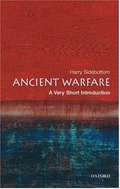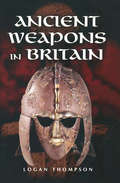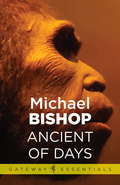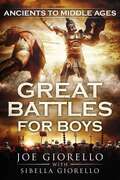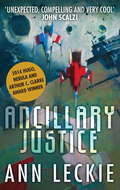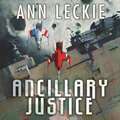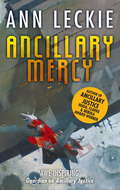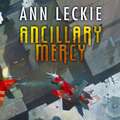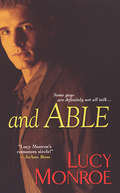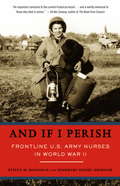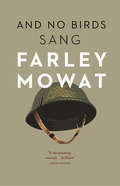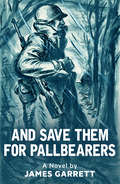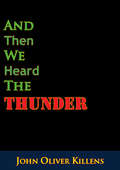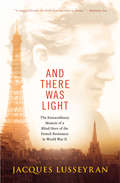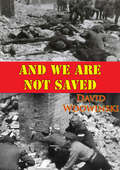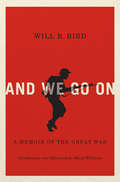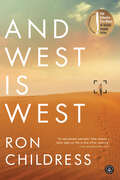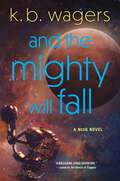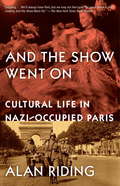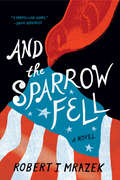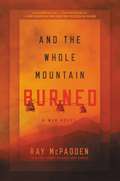- Table View
- List View
Ancient Warfare: A Very Short Introduction
by Harry SidebottomGreek and Roman warfare was unlike that of any other culture before or since. The key difference is often held to be that the Greeks and Romans practiced a "Western Way of War," in which the aim is an open, decisive battle--won by courage instilled, in part, by discipline. Here, Harry Sidebottom looks at how this Western Way of War was constructed and maintained by the Greeks and Romans and why this concept is so prevalent today. All aspects of ancient warfare are thoroughly examined--from philosophy and strategy to the technical skills needed to fight. Sidebottom examines war in the wider context, showing how wars were able to shape classical society, and how an individual's identity was sometimes constructed by war, as in the case of the Christian soldier fighting in God's name. He also explores the ways in which ancient society thought about conflict: Can a war be just? Why was siege warfare particularly bloody? What role did divine intervention play in the outcome of a battle? Taking fascinating examples from the Iliad, Tacitus, and the Persian Wars, Sidebottom uses arresting anecdotes and striking visual images to show that any understanding of ancient war is an ongoing process of interpretation.
Ancient Weapons in Britain
by Logan ThompsonA groundbreaking study of the weaponry used in combat thousands of years ago. Few accounts of ancient warfare have looked at how the weapons were made and how they were actually used in combat. Logan Thompson's pioneering survey traces the evolution of weapons in Britain across three thousand years, from the Bronze Age to the Battle of Hastings in 1066. Insights gained from painstaking practical research and technical analysis shed new light on the materials used, the processes of manufacture, the development of the weapons, and their effectiveness. His account features new information about the weapons themselves and their origin and design—as well as a fascinating new perspective on the practice of early warfare.
Ancient of Days (Gateway Essentials #295)
by Michael BishopImagine a living specimen of a multimillion-year-old hominid species, Homo habilis, encountering the contemporary world. Told in the first-person narrative of Paul Loyd, divorced owner of a small town restaurant, Ancient of Days tells the story of a habiline man found wandering in a Georgia pecan orchard, a living descendant of a habiline tribe, brought from Africa via Haiti as a slave. Paul's ex-wife, RuthClaire, takes in the living fossil, appropriately naming him Adam, and as an artist she discovers Adam's mute but vibrant artistic sensibility, falls in love with him, and marries him - much to Paul's confusion and dismay.And then the story begins to widen out onto a broader canvas, as Adam first faces persecution by small town Georgia Klansmen, then, surviving that, moves with RuthClaire to Atlanta and encounters the whole spectrum of American culture, from art critics and media spectacles to evangelists and punk clubs.Throughout the peregrinations and travails of Adam, however, runs a rich and developing strain of self-conscious spiritual, intellectual, and artistic growth, interwoven with Adam's genuine anguish over the problematic nature of his true humanity.In the end, the central characters come together on the Haitian island of Montarez in the aftermath of crisis, and in a moment of illumination and revelation meet the mysterious and extraordinary origins of Adam and his race in human prehistory.
Ancients To Middle Ages (Great Battles for Boys)
by Joe GiorelloSpartans! Persians! Romans! Historic warriors who changed the world. But does your son know why these soldiers were fighting? <p><p> In this installment of the bestselling series, boys travel to the ancient world to learn about twelve famous military battles that drastically altered world history. They'll also learn about the notable men who led those battles, including Alexander the Great, Julius Casaer, and William "Braveheart" Wallace, among many others. <p><p> Beginning in Ancient Greece and Persia, the battles continue into the Middle Ages—including the Crusades—and conclude with the year 1588 when the Spanish Armada's attempted invasion of England, and the dawn of modern naval warfare.
Ancillary Justice: THE HUGO, NEBULA AND ARTHUR C. CLARKE AWARD WINNER (Imperial Radch #1)
by Ann LeckieThe record-breaking debut novel that won every major science fiction award in 2014, Ancillary Justice is the story of a warship trapped in a human body and her search for revenge. Ann Leckie is the first author to win the Arthur C. Clarke, the Nebula and the Hugo Award for Best Novel in the same year.They made me kill thousands, but I only have one target now.The Radch are conquerors to be feared - resist and they'll turn you into a 'corpse soldier' - one of an army of dead prisoners animated by a warship's AI mind. Whole planets are conquered by their own people. The colossal warship called The Justice of Toren has been destroyed - but one ship-possessed soldier has escaped the devastation. Used to controlling thousands of hands, thousands of mouths, The Justice now has only two hands, and one mouth with which to tell her tale. But one fragile, human body might just be enough to take revenge against those who destroyed her.'ENGAGING AND PROVOCATIVE' SFX Magazine'UNEXPECTED, COMPELLING AND VERY COOL'John Scalzi'HIGHLY RECOMMENDED'Independent on Sunday'MIND-BLOWING'io9.com'THRILLING, MOVING AND AWE-INSPIRING'Guardian'UTTER PERFECTION, 10/10'The Book Smugglers'ASTOUNDINGLY ASSURED AND GRACEFUL'Strange Horizons'ESTABLISHES LECKIE AS AN HEIR TO BANKS'Elizabeth BearThe Imperial Radch trilogy begins with Ancillary Justice, continues in Ancillary Sword and concludes with Ancillary Mercy. Also available now: Provenance is a stunning standalone adventure set in the same world as Ancillary Justice. NPR calls it 'A fitting addition to the Ancillary world'.
Ancillary Justice: THE HUGO, NEBULA AND ARTHUR C. CLARKE AWARD WINNER (Imperial Radch #1)
by Ann LeckieThe record-breaking debut novel that won every major science fiction award in 2014, Ancillary Justice is the story of a warship trapped in a human body and her search for revenge. Ann Leckie is the first author to win the Arthur C. Clarke, the Nebula and the Hugo Award for Best Novel in the same year.They made me kill thousands, but I only have one target now.The Radch are conquerors to be feared - resist and they'll turn you into a 'corpse soldier' - one of an army of dead prisoners animated by a warship's AI mind. Whole planets are conquered by their own people. The colossal warship called The Justice of Toren has been destroyed - but one ship-possessed soldier has escaped the devastation. Used to controlling thousands of hands, thousands of mouths, The Justice now has only two hands, and one mouth with which to tell her tale. But one fragile, human body might just be enough to take revenge against those who destroyed her.'ENGAGING AND PROVOCATIVE' SFX Magazine'UNEXPECTED, COMPELLING AND VERY COOL'John Scalzi'HIGHLY RECOMMENDED'Independent on Sunday'MIND-BLOWING'io9.com'THRILLING, MOVING AND AWE-INSPIRING'Guardian'UTTER PERFECTION, 10/10'The Book Smugglers'ASTOUNDINGLY ASSURED AND GRACEFUL'Strange Horizons'ESTABLISHES LECKIE AS AN HEIR TO BANKS'Elizabeth BearThe Imperial Radch trilogy begins with Ancillary Justice, continues in Ancillary Sword and concludes with Ancillary Mercy. Also available now: Provenance is a stunning standalone adventure set in the same world as Ancillary Justice. NPR calls it 'A fitting addition to the Ancillary world'.
Ancillary Mercy: The conclusion to the trilogy that began with ANCILLARY JUSTICE (Imperial Radch #3)
by Ann LeckieAncillary Mercy is the stunning conclusion to the trilogy that began with Ancillary Justice, the only novel ever to win the Hugo, Nebula, and Arthur C. Clarke Awards. For a moment, things seemed to be under control for Breq, the soldier who used to be a warship. Then a search of Athoek Station's slums turns up someone who shouldn't exist and a messenger from the mysterious Presger empire arrives, as does Breq's old enemy, the divided, heavily armed, and possibly insane Anaander Mianaai - ruler of an empire at war with itself.Breq could flee with her ship and crew, but that would leave the people of Athoek in terrible danger. Breq has a desperate plan. The odds aren't good, but that's never stopped her before.The Imperial Radch trilogy begins with Ancillary Justice, continues in Ancillary Sword and concludes with Ancillary Mercy. Also available now: Provenance is a stunning standalone adventure set in the same world as Ancillary Justice. NPR calls it 'A fitting addition to the Ancillary world'.Praise for the trilogy:'ENGAGING AND PROVOCATIVE' SFX Magazine'UNEXPECTED, COMPELLING AND VERY COOL'John Scalzi'HIGHLY RECOMMENDED'Independent on Sunday'MIND-BLOWING'io9.com'THRILLING, MOVING AND AWE-INSPIRING'Guardian'UTTER PERFECTION'The Book Smugglers'ASTOUNDINGLY ASSURED AND GRACEFUL'Strange Horizons'ESTABLISHES LECKIE AS AN HEIR TO BANKS'Elizabeth Bear
Ancillary Mercy: The conclusion to the trilogy that began with ANCILLARY JUSTICE (Imperial Radch #3)
by Ann LeckieThe stunning conclusion to the trilogy that began with the Hugo, Nebula, and Arthur C. Clarke award-winning Ancillary Justice.For just a moment, things seem to be under control for the soldier known as Breq. Then a search of Atheok Station's slums turns up someone who shouldn't exist - someone who might be an ancillary from a ship that's been hiding beyond the empire's reach for three thousand years. In the meantime a messenger from the alien and mysterious Presger empire arrives, as does Breq's enemy, the divided and quite possibly insane Anaander Mianaai - ruler of an empire that's at war with itself.Anaander is heavily armed and extremely unhappy with Breq. She could take her ship and crew and flee, but that would leave everyone at Athoek in terrible danger. Breq has a desperate plan. The odds aren't good, but that's never stopped her before.
And Able
by Lucy MonroeThe bestselling author of Willing &“weaves a fast action-filled tale fraught with danger and filled with mind blowing romance . . . [an] explosive conclusion&” (SingleTitles.com). Meet three sexy men taking on the bad guys at every turn. They&’ll get the job done—if the price is right and so is the cause . . .Claire Sharp trusts few people and relies on no one. But after her life is threatened, ex-mercenary Brett Adams blows into her self-contained world, full of southern charm and rugged good looks. But Claire is not about to fall into Brett&’s bed. For one thing, the guy has a no-commitment clause that would stump most big-shot attorneys, and for another, despite her response to his sensual kisses, in Claire&’s experience sex isn&’t exactly fireworks and brass bands . . .Brett plans to prove her wrong. He&’ll give her a white-hot pleasure like nothing she&’s ever known and she&’ll realize that some things in life are worth every risk. When the threat to Claire grows dangerously close, pitting them against deadly odds, Brett will do whatever it takes to save her. Because Claire Sharp has just found herself a man who&’s ready to bring it on, willing to do what it takes, and able to go the distance . . .&“The clever, suspenseful plot and intriguing characters are blended together in perfect balance, with plenty of steam to spice things up.&” —Blue Ribbon Reviews
And All the Phases of the Moon
by Judy Reene SingerDelving into the mysteries of the human heart with humor and emotion, master storyteller Judy Reene Singer explores what it means to begin again after a life touched by tragedy . . . Aila Cordeiro absolutely cannot take on an abandoned pit bull. So why is she suddenly filling food bowls for the wounded stray and opening her seaside home to him? Maybe it’s the sadness in the pup’s eyes, a sorrow that mirrors her own. But caring for another is not on Aila’s agenda anymore. As the sole owner of the general store in a Cape Cod tourist town, she has enough on her hands. Besides Aila can’t love anyone ever again. Not since her husband—her heart—boarded a boat with her beloved father two years ago, never to return . . . Of course, life is what happens while you’re making other plans. Now instead of solitude and grief, Aila is suddenly at the center of controversy in the small town. And the only person on her side, besides her best friend, is a stranger whose heart might be more battered than her own. Ex-Navy seal Sam Ahmadi has seen his share of misfortune, which is why Aila never expects him to be the one to show her how to live again in the face of shattering loss. How to hope for the happiness you once dreamed of . . . “Page-turning, beautifully written . . .”—Library Journal on In the Shadow of Alabama, STARRED REVIEW
And If I Perish: Frontline U. S. Army Nurses in World War II
by Rosemary Neidel-Greenlee Evelyn MonahanIn documenting the contributions of the unsung nurses of the US Army Corps in World War II campaigns, women who served in the Women's Army Corps and Navy Nurse Corps in the 1960s, respectively, honor the frontline service of some 60,000 volunteers and their contribution to changing attitudes about women's roles. The book includes period and contemporary photos. Annotation ©2004 Book News, Inc. , Portland, OR (booknews. com)
And Miles to Go: The Biography of a Great Arabian Horse, Witez II
by Linell Smith[from the book jacket] The great Arabian horse Witez II endured the hardships of the Second World War in Europe, then came to the United States to found a dynasty to rival that of Man-O-War. This is his biography, told from actual sources in Europe and America. Except for details of his early life in Poland, where records were scant, it is all true. Witez II was foaled under the White Eagle of Poland, matured under the German Swastika, and achieved his greatest fame in America. His story includes that of the Poles who reared him, the Germans who cared for him, and the Americans who were lucky enough to secure him at an Army auction. In this book with Witez are Stasik Kowalski, the young Pole who risked his life for him; the two German veterinarians who surrendered to the Allies to save their horses; and Witez's American owners, Earle and Frances Hurlbutt. The fine breeding policies of the latter resulted in the remarkable Arabians sired by Witez. But most important of all is Witez himself, the horse whose name meant "chieftain and knight, prince and hero, all rolled into one." Witez II fulfilled the promise of his name. Linell Smith is herself a breeder of Arabian horses on the Maryland farm where she lives with her husband, their three daughters and an array of pets which include cats, dogs, horses, and goats. Of And Miles to Go she says, "This book wrote itself, really. The story was there; it simply needed to be set down. The research work required to make the book as accurate as possible was absolutely fascinating--from my trip to Poland through my lively correspondence with the charming Frances Hurlbutt. "By far the most important element of Witez's story was the amazing effect he had on those who were close to him. The people who loved Witez broke through the blank walls of groups and found each other. I myself, in the process of tracking him to his beginnings, felt at home in a strange land whose political philosophy differed strongly from mine. The kindness and gracious hospitality offered me were more than enough to make any stranger comfortable, but the great thing was getting to know the people and finding that they were friends. My thanks to Witez. It was a welcome lesson and one that has given me joy." Images are described.
And No Birds Sang
by Farley MowatTurned away from the Royal Canadian Air Force for his apparent youth and frailty, Farley Mowat joined the infantry in 1940. The young second lieutenant soon earned the trust of the soldiers under his command, and was known to bend army rules to secure a stout drink, or find warm - if non-regulation - clothing. But when Mowat and his regiment engaged with elite German forces in the mountains of Sicily, the optimism of their early days as soldiers was replaced by despair. With a naturalist's eyes and ears, Mowat takes in the full dark depths of war - and his moving account of military service, and the friends he left behind, is also a plea for peace. It is one of the most searing and unforgettable World War II memoirs from any Canadian.
And Save Them For Pallbearers
by James GarrettAnd Save Them for Pallbearers, first published in 1958, is a gritty World War II novel centered on a platoon of U.S. GI’s, fighting from D-Day to the Battle of the Bulge. Main character Sergeant Peter Donatti is wounded on an attack on the Siegfried Line, and while in an army hospital in Paris, meets nurse Lt. Abigail Winslow, and a romance develops. Although he is scheduled to return to the U.S., Donatti instead returns to his outfit. His return to the front has tragic consequences as the fierce fighting of the Battle of the Bulge is beginning, and Donetti will pay the ultimate price.From the dust jacket: To read Peter Donatti’s story is to come face to face with the taste of truth, with the deepest feelings of a man whose life was measured by the distance between him and the nearest shell burst. Indeed, to read it is to discover a truly great novel of World War II, a rare work of fiction that brings with it a profoundly honest understanding of the forces that shape the destinies of all men and women.
And Then We Heard The Thunder
by John Oliver KillensA fictional portrayal of real events that occurred during WWII from Afro-American author John Oliver Killens, who had previously served in the Amphibian Forces in the South Pacific. Through his characters, the reader gains a close-to-the-bone account of what it was like to be a Negro soldier fighting in segregated units under racist commanding officers. The final chapters reveal one of the war's best-kept secrets concerning the escalating racial tension between black American GIs and their white commanding officers. The story climaxes in a terrifying race riot, which took place on the seedy night streets of South Brisbane in March 1942.Editorial Reviews:"...a big and powerful, angry novel, pulsating with love and hate, laughter and tears, sex and violence, and all the other juices of life."--Sidney Poitier"...that big, polyphonic, violent novel...calls James Jones to mind."--Saturday Review"...A beautiful and powerful book."--James Baldwin
And There Was Light: The Extraordinary Memoir of a Blind Hero of the French Resistance in World War II
by Jacques LusseyranThe book that helped inspire Anthony Doerr’s All the Light We Cannot See An updated edition of this classic World War II memoir, chosen as one of the 100 Best Spiritual Books of the Twentieth Century, with a new photo insert and restored passages from the original French edition When Jacques Lusseyran was an eight-year-old Parisian schoolboy, he was blinded in an accident. He finished his schooling determined to participate in the world around him. In 1941, when he was seventeen, that world was Nazi-occupied France. Lusseyran formed a resistance group with fifty-two boys and used his heightened senses to recruit the best. Eventually, Lusseyran was arrested and sent to the Buchenwald concentration camp in a transport of two thousand resistance fighters. He was one of only thirty from the transport to survive. His gripping story is one of the most powerful and insightful descriptions of living and thriving with blindness, or indeed any challenge, ever published.
And We Are Not Saved
by David WdowinskiSuccinctly and powerfully recounts the experiences of the author, a founding member of the Jewish Military Union, and important witness during the trial of Nazi criminal Adolf Eichmann. (EJ 2007) "Because the author was a leader of a major Jewish political party in Poland he is able to give us an understanding of the historical and social conditions that preceded the holocaust and gave it its impetus. Because he is a trained psychiatrist, we get illuminating insights into the behavior of the individuals and the masses, both heroic and inhumanly brutal, that determined the tragic destiny of the Jews throughout Europe."
And We Go On
by David Williams Will R. BirdIn the autumn of 1915 Will Bird was working on a farm in Saskatchewan when the ghost of his brother Stephen, killed by German mines in France, appeared before him in uniform. Rattled, Bird rushed home to Nova Scotia and enlisted in the army to take his dead brother's place. And We Go On is a remarkable and harrowing memoir of his two years in the trenches of the Western Front, from October 1916 until the Armistice. When it first appeared in 1930, Bird's memoir was hailed by many veterans as the most authentic account of the war experience, uncompromising in its portrayal of the horror and savagery, while also honouring the bravery, camaraderie, and unexpected spirituality that flourished among the enlisted men. Written in part as a reaction to anti-war novels such as All Quiet on the Western Front, which Bird criticized for portraying the soldier as "a coarse-minded, profane creature, seeking only the solace of loose women or the courage of strong liquor," And We Go On is a nuanced response to the trauma of war, suffused with an interest in the spiritual and the paranormal not found in other war literature. Long out of print, it is a true lost classic that arguably influenced numerous works in the Canadian literary canon, including novels by Robertson Davies and Timothy Findley.
And We Go On: A Memoir of the Great War (Carleton Library Series #229)
by David Williams Will R. BirdIn the autumn of 1915 Will Bird was working on a farm in Saskatchewan when the ghost of his brother Stephen, killed by German mines in France, appeared before him in uniform. Rattled, Bird rushed home to Nova Scotia and enlisted in the army to take his dead brother's place. And We Go On is a remarkable and harrowing memoir of his two years in the trenches of the Western Front, from October 1916 until the Armistice. When it first appeared in 1930, Bird's memoir was hailed by many veterans as the most authentic account of the war experience, uncompromising in its portrayal of the horror and savagery, while also honouring the bravery, camaraderie, and unexpected spirituality that flourished among the enlisted men. Written in part as a reaction to anti-war novels such as All Quiet on the Western Front, which Bird criticized for portraying the soldier as "a coarse-minded, profane creature, seeking only the solace of loose women or the courage of strong liquor," And We Go On is a nuanced response to the trauma of war, suffused with an interest in the spiritual and the paranormal not found in other war literature. Long out of print, it is a true lost classic that arguably influenced numerous works in the Canadian literary canon, including novels by Robertson Davies and Timothy Findley. In an introduction and afterword, David Williams illuminates Bird's work by placing it within the genre of Great War literature and by discussing the book's publication history and reception.
And West Is West: A Novel
by Ron Childress“This compelling debut novel, which won the PEN/Bellwether Prize for Socially Engaged Fiction, dramatically examines the insidious role unrestrained technology plays in the moral and ethical corruption of people, institutions, and government . . . This is an excellent story, well told, suspenseful, and tragic.” —Publishers Weekly When Jessica, a young Air Force drone pilot in Nevada, is tasked with launching a missile against a suspected terrorist halfway across the world, she realizes that though women and children are in the crosshairs of her screen, she has no choice but to follow orders. Ethan, a young Wall Street quant, is involved in a more bloodless connection to war when he develops an algorithm that enables his company’s clients to profit by exploiting the international financial instability caused by exactly this kind of antiterrorist strike. These two are only minor players, but their actions have global implications that tear lives apart—including their own. And West Is West is a politically and socially charged book whose author has crafted a terrifyingly real scenario. “Impressive and keenly relevant to our time. And West Is West moves seamlessly between drone strikes and high-speed trading on Wall Street. I devoured it in forty-eight hours, and during the hours I wasn’t reading it, I was thinking about it. I still am . . . This writer can write; these characters are real; the story is crackerjack.” —Barbara Kingsolver “I’m impressed by the power of Ron Childress’s voice and the accuracy with which he describes human behavior. He’s an intelligent and gifted writer who doesn’t show off--he knows how to tell a story that you won’t forget.” —Terry McMillan
And the Mighty Will Fall: A NeoG Novel (NeoG #4)
by K. B WagersWith the fourth stand-alone NeoG novel, Die Hard meets A Long Way to a Small, Angry Planet in this nail-biting, action-filled story that’s as much about found family as it is about survival when a peaceful transition of power in the Mars Orbital Station goes terribly wrong as rebels decide this is the moment to make their move, leaving two NeoG members stranded inside a ticking time bomb.When you’re trapped in space, there’s no way out.The mission of the Near-Earth Orbital Guard is to ensure the peace and security of the solar system. Commander Maxine Carmichael and Lieutenant Commander Saqib Vahid are at the Mars Orbital Station (MOS) to help facilitate the official handover from NeoG to Mars civilian control as part of the ongoing negotiations. Members of the extreme wings of the fight for Martian independence refuse to remain silent, and are willing to resort to violence to make their voices heard; Max and Saqib find themselves fighting for their lives. The attacks both on the MOS and the ground of Mars sets off a chain reaction that could destabilize the last few years of cautious peace.The leader of Free Mars, Sylvia Moroz, knows better than anyone how fragile harmony is, having seen for decades the Coalition of Human Nations’ inability to negotiate for peace. Without any assurances—and knowing her splintered people all too well—anything less than complete liberation will only lead to more bloodshed. She’s not opposed to fighting, but when there’s an attempt on her life, she finds she must look for help from the NeoG and Commander D’Arcy Montaglione. The pair will have to overcome their past to figure out who they can trust and how to stop the attacks on the ground before more lives are lost.Trapped inside the station, Carmichael and Vahid are scrambling to not only get to the bottom of the attackers’ motives, but also to simply survive. Because with the rest of the Zuma’s Ghost crew stuck down on Mars, it’s up to them to do what they can to keep the MOS from fully falling into the wrong hands…and keep Mars from descending into all-out war.
And the Show Went On: Cultural Life in Nazi-occupied Paris
by Alan RidingIn June 1940, Paris fell to the Nazis who made the world's cultural capital their favourite entertainment ground. Music halls and cabarets thrived during the occupation, providing plenty of work for actors, singers and musicians - except for Jews. The likes of Maurice Chevalier and Edith Piaf, who had entertained the French troops, now unabashedly provided amusement to the Germans. After the invasion of France, those artists still in Paris had to find ways to survive. Although Matisse and others kept out of view, Picasso could not avoid Nazi visitors. A few, like Beckett, joined the Resistance. Some were arrested and died in German hands. Others entertained the enemy. The theatres reopened, the movie cameras rolled, galleries sold paintings looted from Jewish families, pro-German writers and their rivals fought in print. Told through the experiences of renowned creative figures and witnesses of the times, And the Show Went On is an authoritative account of how Paris's artistic world lived through the Occupation, both of those who suffered Nazi oppression and those who prospered through collaboration.
And the Sparrow Fell: A Novel
by Robert J. MrazekAnd the Sparrow Fell is a coming-of-age tale set against the backdrop of the Vietnam War. Former U.S. Congressman Robert J. Mrazek tells the story of a wealthy family on the north shore of Long Island in the spring of 1967. Cornell undergraduate Rick Ledbetter goes through a rocky journey of self-discovery as both his family and his country disintegrate around him. Rick is a young rake in the mold of his father, Travis Ledbetter, a Medal of Honor–winning World War II navy pilot. Rick has been accepted into the swift boat program at Naval Officer Candidate School and will be heading for combat in Vietnam. Rick’s brother Tom, also a Cornell undergraduate, is a young man of true conscience who, because of his Christian faith, is morally opposed to the war. He has rejected conscientious-objector status. Rick meets and falls in love with Kate Kurshan, who is Tom’s girlfriend. She is also a Cornell student who opposes the war. Their three lives intersect as Rick, who becomes a war hero, discovers the human cost of war, while Tom, who has great moral courage, puts his life on the line in protest of the Vietnam War at a terrible personal cost.
And the Whole Mountain Burned: A War Novel
by Ray McPaddenFour-tour combat veteran Ray McPadden offers a vivid portrayal of American soldiers facing an unseen enemy and death in the Mountains of Afghanistan.Sergeant Nick Burch has returned to the crags of tribal Afghanistan seeking vengeance. Burch's platoon has one goal: to capture or kill an elusive insurgent, known as the Egyptian, a leader who is as much myth as he is man, highly revered and guarded by ferocious guerrillas. The soldiers of Burch's platoon look to him for leadership, but as the Egyptian slips farther out of reach, so too does Burch's battle-worn grasp on reality. Private Danny Shane, the youngest soldier in the platoon, is learning how to survive. For Shane, hunting the Egyptian is secondary. First he must adapt to the savage conditions of the battlefield: crippling heat, ravenous sand fleas, winds thick with moondust, and a vast mountain range that holds many secrets. Shane is soon chiseled by combat, shackled by loyalty, and unflinchingly marching toward a battle from which there is no return. A new enemy has emerged, one who has studied the American soldiers and adapted to their tactics. Known as Habibullah, a teenage son of the people, he stands in brazen defiance of the Ameriki who have come to destroy what his ancestors have built. The American soldiers may be tracking the Egyptian, but Habibullah is tracking them, and he knows these lands far better than they do. With guns on full-auto, Shane and Burch trek into the deepest solitudes of the Himalayas. Under soaring peaks, dark instinct is laid bare. To survive, Shane and Burch must defeat not just Habibullah's militia but the beast inside themselves.AND THE WHOLE MOUNTAIN BURNED reveals, in stunning, ruthless detail, the horrors of war, the courage of soldiers, and the fact that no matter how many enemies we vanquish, there is always another just over the next ridge.
And the World Went Dark: An Illustrated Interpretation of the Great War
by Steven N. PatriciaThis beautiful and evocative book gives an illustrated overview of the First World War, on land, on sea and in the air. With original drawings in full colour, Steven Patricia uses 30 years’ experience as a historical illustrator to give an informative and insightful account of the war, portraying the human faces of the participants and capturing moments in time with a vividness and immediacy that brings home both the emotional impact and the tragedy of war. Accompanied by soldier’s diary extracts and other contemporary literature, there are many drawings of the hardware of war: aircraft and airships, submarines and ships, guns and grenades. We also get a glimpse of weary officers relaxing in an RAF mess, see panicking sailors swimming desperately away from a sinking ship, soldiers stumbling across no-man’s land, and the dramatic scene of one of last great cavalry charges of any war, in Egypt. The role of animals is featured, including the importance of horses and rescue and messenger dogs. The text gives a concise introduction to the events of the war and why it started, with maps of the different fronts where fighting took place and a diagram of a trench system. Designed for readers with little familiarity of the conflict, this is a unique and unmissable book in the centenary of the ‘war to end all wars’.
